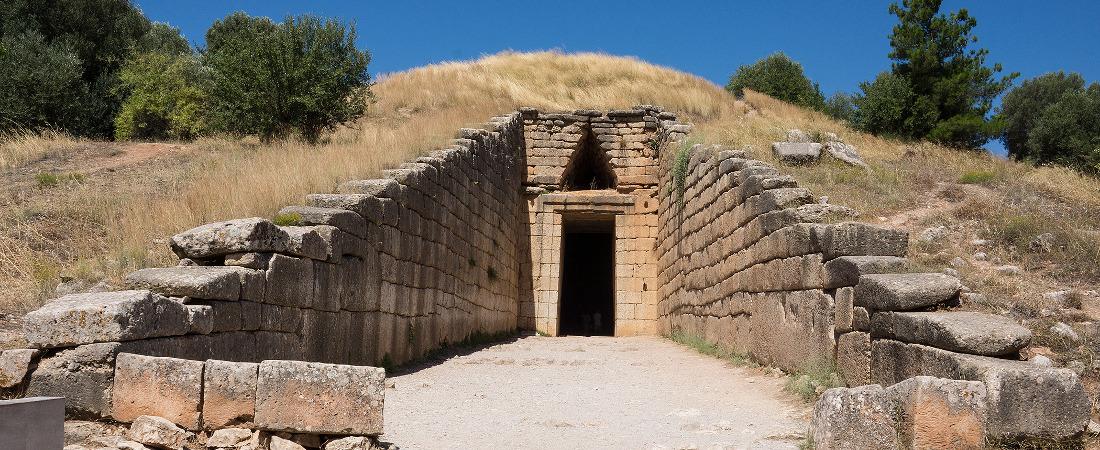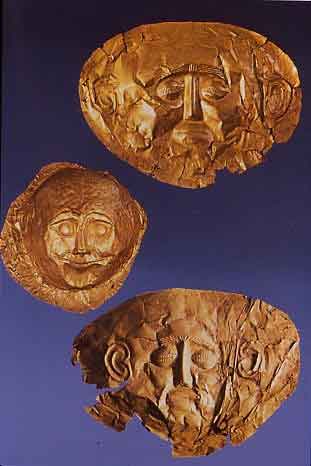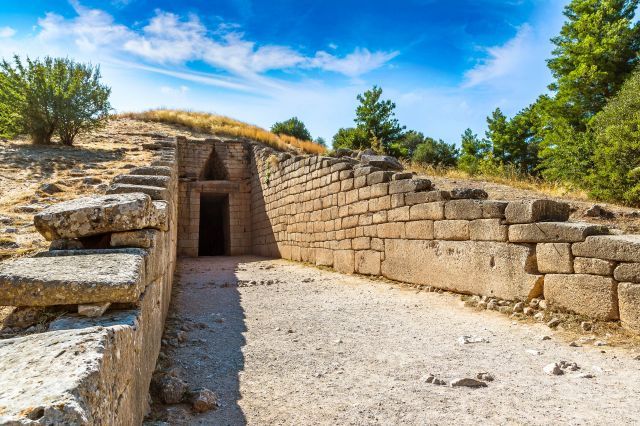Discover Mycenae: Greece's Ancient Archaeological Marvel

If you're a history enthusiast or simply love exploring ancient wonders, prepare to be amazed by Mycenae, a captivating archaeological marvel located in Greece. This ancient city is steeped in historical significance and offers a unique glimpse into the rich and fascinating past of the Greeks.
Overview of Mycenae and its historical significance
Mycenae was once a dominant city-state in ancient Greece and played a crucial role in shaping the civilization of the time. It was a major power centre during the Late Bronze Age, known as the Mycenaean period. The city was fortified with massive walls, impressive buildings, and intricate architectural designs.
The Greeks believed that Perseus, the legendary hero of Greek mythology, founded Mycenae. It is also known as the home of King Agamemnon, the leader of the Greek forces in the Trojan War, as depicted in Homer's epic poem, the Iliad.
The city flourished economically and culturally, producing exquisite works of art, such as pottery, jewellery, and sculptures. Its influence extended throughout the Mediterranean, and Mycenaean civilization impacted subsequent Greek culture and society.
The excavation and discovery of Mycenae
Mycenae was buried beneath layers of earth and forgotten for centuries until its rediscovery in the 19th century by Heinrich Schliemann, a German businessman and amateur archaeologist. In his pursuit of Homeric Troy, he uncovered the magnificent ruins of Mycenae, revealing a civilization long lost to time.
The excavations unearthed grand palaces, beehive tombs, ancient artefacts, and treasures, providing valuable insight into the Mycenaean civilization and validating the historical accounts depicted in ancient Greek texts.
Today, visitors to Mycenae can explore the renowned Lion Gate, the imposing entrance to the ancient city, which features two massive stone lions and breathtaking views of the surrounding landscape. The Treasury of Atreus, a stunning beehive tomb, is another must-see attraction, showcasing the incredible engineering prowess of the Mycenaeans.
Mycenae is a testament to the remarkable achievements of an ancient civilization and offers a journey through time that enlightens and inspires visitors from around the world.

Historical Background
The Mycenaean civilization and its rise to power
If you're a history enthusiast or love exploring ancient ruins, you're in for a treat at Mycenae, one of Greece's most fascinating archaeological marvels! Step back in time as you discover the historical background that shaped this ancient civilization.
Mycenae was the centre of the Mycenaean civilization, which thrived from approximately 1600 to 1100 BC. This Bronze Age civilization dominated the Greek mainland and its surrounding islands. The Mycenaeans were known for their impressive palaces, fortifications, and advanced culture.
Mycenae's rise to power began around 1600 BC when it became the leading city-state in the Peloponnese region. The Mycenaeans rapidly expanded their influence, establishing trade connections with neighbouring regions and accumulating vast wealth.
The influence of Mycenae on ancient Greece
Discovering Mycenae allows you to appreciate this ancient city's immense impact on Greek civilization. The Mycenaeans played a pivotal role in shaping ancient Greece in several ways.
Firstly, their military might and sophisticated fortifications were unparalleled, making Mycenae an impregnable fortress. The famous Lion Gate, adorned with intricately carved lions, is a testament to the Mycenaeans' power and craftsmanship.
Secondly, Mycenae's political and economic influence extended beyond its borders. The Mycenaeans controlled key trade routes and commerce with other Mediterranean civilizations, including Egypt and Crete.
Finally, the Mycenaeans left a lasting cultural legacy. Their artwork, which includes intricate gold jewellery and detailed frescoes, is a testament to their artistic skill and aesthetic sensibilities. Mycenae also played a central role in Greek mythology, with legendary figures like King Agamemnon and the Trojan War closely associated with the city.
A visit to Mycenae offers a captivating journey into Greece's ancient past. The rise of the Mycenaean civilization and its significant influence on ancient Greece are just a glimpse of the wonders you'll uncover. So pack your bags and embark on an adventure to discover the awe-inspiring ruins of Mycenae!

Exploring Mycenae
The Lion Gate and entrance to the citadel
Welcome to the ancient city of Mycenae, a true archaeological marvel located in Greece. As you step through the impressive Lion Gate, you'll be transported back to a civilization that flourished thousands of years ago. The Lion Gate, with its imposing stone lions, serves as the grand entrance to the citadel and sets the tone for the incredible sights that await you.
Beyond the Lion Gate, you'll be in awe of the fortified walls enclosing the citadel. These massive stone walls stand as a testament to the engineering brilliance of the Mycenaean civilization. As you explore the pathways within the citadel, you'll discover ancient ruins, tombs, and remnants of what was once a thriving ancient city.
The Royal Palace and its architectural marvels
One of the highlights of Mycenae is the Royal Palace, where the ruling kings and queens resided. As you walk through the ruins, you can't help but be amazed by the architectural marvels constructed thousands of years ago. The monumental entranceway, the Megaron, is a sight to behold with its grand columns and intricate engraved decorations.
Inside the Royal Palace, you'll find the Throne Room, where the rulers of Mycenae held court and made significant decisions for their kingdom. The room is adorned with beautiful artwork and intricate frescoes depicting ancient mythology scenes. As you stand in this historic space, you can't help but feel the weight of history and marvel at the civilization that thrived here.
In addition to the Royal Palace, Mycenae is home to other fascinating archaeological sites. The Treasury of Atreus, known as the Tomb of Agamemnon, is a stunning burial structure showcasing Mycenaean engineering mastery. The famous Grave Circle A, which contains royal tombs, offers a glimpse into the elaborate burial rituals of the Mycenaean civilization.
A visit to Mycenae is a journey back in time, where you can immerse yourself in the wonders of an ancient civilization. From the awe-inspiring Lion Gate to the Royal Palace and other architectural marvels, Mycenae will leave you captivated by its rich history and unparalleled beauty.

Treasures of Mycenae
The mask of Agamemnon and its archaeological significance
Welcome to Mycenae, an ancient archaeological marvel located in Greece. As you explore this extraordinary site, one of the most captivating artefacts you'll discover is the mask of Agamemnon. This golden funerary mask is believed to have belonged to Agamemnon, the legendary king of Mycenae and leader of the Greek forces during the Trojan War.
The mask of Agamemnon holds immense archaeological significance as it provides insights into the ancient Mycenaean civilization. Its intricate details, including the finely crafted beard and facial features, showcase the skill and craftsmanship of the ancient artisans. This iconic mask has become a symbol of Mycenae and a representation of Greece's rich heritage and history.
The Treasury of Atreus and its impressive dome structure
As you continue your journey through Mycenae, don't miss the opportunity to visit the Treasury of Atreus. This awe-inspiring structure is an ancient tomb known for its remarkable dome-shaped architecture. Built with massive stones, the Treasury of Atreus stands as a testament to the engineering prowess of the Mycenaeans.
The impressive dome structure of the Treasury of Atreus is a masterpiece of ancient engineering. It showcases the innovative techniques used by the Mycenaeans to construct grand tombs. The sheer magnitude of this architectural marvel leaves visitors in awe of the ancient civilization's accomplishments.
As you explore Mycenae, take the time to appreciate the mask of Agamemnon and the Treasury of Atreus. These incredible artefacts and structures will transport you back in time and offer a glimpse into the fascinating world of the Mycenaean civilization. Whether you are a history enthusiast or simply curious about ancient cultures, Mycenae is a destination that will leave you amazed and inspired.
Mycenae's Legendary Stories
The myths and legends associated with Mycenae
Mycenae, the ancient city in Greece, holds a prominent place in history and is steeped in myths and legends. These stories have captivated the imagination of people for centuries. Let's explore some of the most fascinating tales associated with Mycenae.
One of the most well-known legends revolves around the founder of Mycenae, King Perseus. According to Greek mythology, Perseus was the son of Zeus and Danae. He is believed to have founded Mycenae after slaying the fearsome Medusa and using her severed head as a weapon.
Another legendary figure associated with Mycenae is King Agamemnon. He played a significant role in the Trojan War, as depicted in Homer's epic poem, the Iliad. Agamemnon, the king of Mycenae, led the Greek forces against Troy to avenge the abduction of Helen, the wife of his brother Menelaus. The story of the Trojan horse and the fall of Troy is closely tied to Mycenae, making it an integral part of this legendary tale.
The Trojan War and its connection to Mycenae
The Trojan War is one of the most iconic events in Greek mythology, and Mycenae played a crucial role in this epic conflict. According to the myth, the Trojan prince Paris abducted Helen, the queen of Sparta, which led to the war between the Greeks and the Trojans.
In the Iliad, Homer describes how Agamemnon and other Greek leaders gathered their forces from various Greek cities, including Mycenae, to sail across the Aegean Sea and wage war on Troy. Mycenae provided warriors and resources, contributing to the Greek victory after a decade-long struggle.
The legendary city of Mycenae is thus intricately connected to the mythical stories of the Trojan War. These tales not only provide a captivating narrative but also showcase the historical significance of this ancient city.
From Perseus's tales to the Trojan War's epic events, the myths and legends associated with Mycenae continue to hold an enchanting allure. They serve as a testament to this remarkable ancient city's rich history and cultural heritage. Exploring these stories allows us to delve deeper into the world of ancient Greece and appreciate the enduring impact of Mycenae.

Practical Information
Visiting Mycenae and its opening hours
If you are planning a trip to Greece and want to immerse yourself in ancient history, include a visit to Mycenae on your itinerary. Located in the northeastern Peloponnese, Mycenae is an ancient archaeological site that dates back to the Bronze Age.
The site is open to visitors year-round so that you can plan your visit according to your schedule. The opening hours vary depending on the season, so it's important to check the official website or contact the site in advance. Generally, the site opens at 8:00 a.m. and closes at 8:00 p.m. during the summer months, while in the winter, the closing time is earlier, around 5:00 p.m.
Guided tours and recommended attractions nearby
Consider joining a guided tour to make the most of your visit to Mycenae. A knowledgeable guide can provide fascinating insights into the history and significance of the site, enriching your experience. Guided tours are available in multiple languages and can be booked in advance.
During your visit, don't miss the chance to explore the various attractions within the archaeological site. The most iconic feature of Mycenae is the impressive Lion Gate, which served as the main entrance to the ancient city. The Treasury of Atreus, also known as the Tomb of Agamemnon, is another must-see attraction. This stunning burial chamber showcases the advanced engineering skills of the Mycenaean civilization.
If you have more time and are interested in further exploring the region, consider visiting other nearby attractions. The ancient theatre of Epidaurus, renowned for its exceptional acoustics, is a short drive from Mycenae and worth visiting. The picturesque town of Nafplio, with its charming old town and stunning views, is also within easy reach and offers a delightful blend of history and modern amenities.
Overall, visiting Mycenae is a captivating journey into Greece's ancient past. With its rich history, remarkable archaeological ruins, and nearby attractions, it is an experience that will leave you in awe of the achievements of the Mycenaean civilization.
